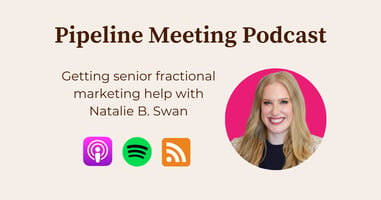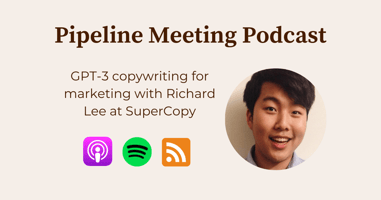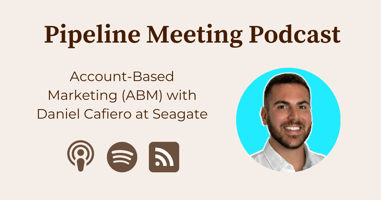Natalie B. Swan joins the pod to talk getting help when you're the head of marketing. Natalie...
Your first sales hire and what's next with Marc Thomas (Episode 20)
The head of growth at Powered By Search, Marc Thomas, joins the show to talk about your first sales hire, what to do when you're getting traction, and a single change you can make to improve all your marketing.
Show Description
Pipeline Meeting is a sales podcast for growth leaders. If you are looking for actionable steps to close high-ticket deals, you’re in the right place.
Tune in for help with things like cold outreach and qualifying inbound leads. We regularly feature guests and experts to take our business to the next level.
Pipeline Meeting is hosted by Harris Kenny, the founder of Intro, a company that provides sales as a service.
Subscribe wherever you get your podcasts: Amazon Music, Apple Podcasts, Castbox, Castro, Deezer, Google Podcasts, Overcast, PlayerFM, Pocket Casts, Podcast Index, RSS, Stitcher, Spotify, TuneIn.
Show Notes
In this episode, Harris asks Marc to share his thoughts on a few topics:
- Role of sales: How does he see the overlap between sales and marketing, and in particular, are there certain companies where salespeople don't make sense? Short answer: Yes, listen to the episode or read the transcript for the reply, because it's a little complicated.
- Repeatability in sales: When has a company achieved repeatability in their sales process, where they feel they are getting closer to Product Market Fit (PMF)? How can you measure that?
- Beyond Product Market Fit: Even if you've got a sense of PMF, is that enough? Marc says you must look at the market part of the equation before proceeding.
- Steps after getting traction: Now that you're scaling, what are the next steps to take in sales and marketing alignment? How do you drive conversion, where would you go next with site content and marketing strategies? Marc's low-volume keyword strategy is an interesting one. Listen or read to hear him explain it.
- One thing to improve all your marketing: To keep it simple, Marc concludes by sharing the one thing that will improve everything about your marketing: Focusing on pain points.
If you found this episode interesting, learn more by visiting introcrm.com
Learn About Our Guest
Powered By Search helps B2B SaaS companies with solid product-market fit who want to make building demand a priority scale MRR at record-breaking speeds.
Visit Powered By Search to learn more about their work.
As director of growth, Marc Thomas works with their clients between $5M ARR and $75M ARR, delivering strategic demand gen programs for companies like Basecamp, OpenPhone, AdvisorEngine, Rally, Reltio and MyCase, and he's building a predictable high-quality pipeline for Powered By Search through their own marketing efforts.
Find Marc Thomas on LinkedIn and on Twitter.
Transcript
Welcome to Pipeline Meeting, a sales podcast for founders and sales leaders. You're going to get ideas that you can apply today to close high-ticket deals and find repeatability in your sales process. Pipeline Meeting is brought to you by Intro, learn more at introcrm.com.
[00:00:20] Harris Kenny: I'm excited to be joined by Marc Thomas. Hi, Marc. Thanks for joining us.
[00:00:23] Marc Thomas: Hey, great to be here, man. Thanks for having me.
[00:00:26] Harris Kenny: The topic that I wanted to bring Marc on to talk about is when you do and don't need sales. Marc has a lot of experience working with software and technology companies. And earlier this year we had a big customer that we lost.
[00:00:39] I was personally doing most of the work for this customer because it's a recognizable name in SaaS. Despite my best efforts, these prospective customers, these trial signups, they just didn't want to talk to anyone.
[00:00:51] It didn't matter what we offered them. They just wanted to use the product. And if they liked it great. And if they didn't, they wouldn't pay for it.
[00:00:57] We tried all this segmentation around their company size and their job title, and we tried to find the enterprisey leads. It just didn't work.
[00:01:04] So the first thing that I would like to talk about, I'm curious, the difference between sales and marketing and if you wanna outline how you think about that. And where those tactics make sense.
[00:01:14] Marc Thomas: It's one of those questions where it really depends, right? But that's a rubbish answer. So, how about I give you some kind of buffers there?
[00:01:22] The first thing I'll say is, yeah, you're totally right.
[00:01:24] Like if you have a low priced product, so let's say, let's say below a thousand dollars ACV, so average contract value, or if you prefer, you can say LTV-- mostly they're interchangeable these days-- it's probably not gonna work out for you. Because the number of deals you'd have to close to make that worthwhile, it's a punishing number.
[00:01:45] Even if you have $10,000 ACV, it's still gonna be fairly challenging. But at least you're getting to the right ballpark there. So that's the baseline, I would say.
[00:01:55] The second thing I would say is that if you don't have product market fit yet, you shouldn't have sales people. That's because there is no salesperson who can sell a product reliably and time after time, who can sell a product that doesn't have product market fit.
[00:02:15] That's a real big one for SaaS companies because they get a couple of customers and think, right, we've nailed it. They're a similar kind of customer, so we'll hire some sales people we'll get on with building the product, and the salesperson will make us rich.
[00:02:30] It just doesn't happen like that.
[00:02:32] There's all sorts of reasons for it. It's a whole book that you could write. But it doesn't work.
[00:02:37] So that's something, don't hire sales people until you have product market fit and you have a high contract value.
[00:02:43] The other thing that I'll say, don't hire sales people if you don't have the pipeline to give them. A lot of people think, if I get someone to fill out a demo request form, or if I get someone to sign up to the product, maybe it's a freemium thing, and then we'll just add sales in on top. That's a win, right? Let's say I get a hundred people to do that.
[00:03:06] The reality is, many of those people won't be good fit customers anyway. So you don't want sales talking to them. The other reality is there's a lot of competition in every single SaaS market.
[00:03:18] The conversion rate, even from people who've indicated that they're going to use your product is still gonna be fairly small.
[00:03:26] There's a difference between signing up to try it, and actually paying for it. You want the people who are gonna actually pay for it to be talking to sales.
[00:03:34] Now, if you've got a hundred people in your pipeline and you've got a ACV or LTV product of like $10,000, then you do the maths on that.
[00:03:45] And you say like 1% of those people, or maybe let's be optimistic five, five to 10% of those people sign up. Is that gonna pay everyone's salaries? Plus, the sales people's salaries? And keep your company running? Probably not.
[00:04:01] Those are the kinds of equations that you need to be doing. You need to be working out, not just, do we have pipeline right now, but how fast can we replenish that?
[00:04:09] Let let's face it, those sales people aren't cheap either. Good people aren't cheap. You need the resource to actually make that work.
[00:04:16] Those are a couple of the things I'd be thinking about.
[00:04:18] Harris Kenny: The one thing you said that I wanna tease out a little bit more is, you said, okay, we've got a couple customers and are starting to look similar, but it's still maybe not enough to have that repeatability yet. When you talk about product market fit, and when is it that I can really say that I've got an idea of my customer?
[00:04:38] How do you think about that from a marketing perspective? Does that mean that everyone's in the same industry, that everyone has the same job title that there business is in the same place? Is it all of those things?
[00:04:49] Marc Thomas: Well, there's are a lot of factors at play here, but I'll give you some of the ones that we use with our clients are Powered By Search.
[00:04:55] One of the things that we look at is NPS score. If you have a segment of your market, that you think is looking similar.
[00:05:04] That could be by firmographic data, so sizes of companies, industries, even location potentially, or equity. You wanna try and work out, which ones are having the most success in terms of happiness.
[00:05:19] NPS would be a good proxy for that. Do an NPS survey over a couple of quarters. And you'll see that some of those segments are having a higher score than others.
[00:05:33] Now, if you're getting a higher MPS score in a segment that is quite well defined in terms of firmographic data, that's something you should hold and you should say, is this, our market, is this our actual customer.
[00:05:49] Good way to test that is to say, if you get one or two of those kind of very clear customer segments, you could run some tests with marketing.
[00:05:58] So maybe you change your messaging on your landing pages to only speak to those people and their specific problems. What's the implication of that on your marketing and your conversion rates downstream? Are you finding that you are getting more deals closed or fewer deals closed?
[00:06:14] If it's fewer, you need to go back to the drawing board. If it's more, then great.
[00:06:19] The second question though, you still need to ask, and this is relevant to the first thing, is even if I find that customer, is there enough of that customer to actually have a business here?
[00:06:30] Because it's no point saying, this is a weird example, but I've created a CRM for for piano tuners in Chicago.
[00:06:36] Now piano tuners in Chicago, how many of those there gonna be? There's probably gonna be like 60, a hundred, maybe, piano tuning businesses in Chicago, right? There's not gonna be that much of a market, but they might have off the charts satisfaction with your CRM.
[00:06:52] So the question is, can you widen that and still have the same sort of results? Can you also talk to piano tuners in North America? Or, the Western seaboard?
[00:07:01] That would be kind of a way to go about that. It's really about what data do you have? How can you segment that? And how can you test your assumptions and the kind of the findings of your data?
[00:07:14] You can also look at things like customer support tickets. Are you getting many from one kind of customer? Another thing that a lot of people never factor in is, do we actually want this kind of customer?
[00:07:24] You don't necessarily want ad execs using your product cuz they demand a lot of stuff, right? That's an example, again. You need to be sure that if you're gonna put 5, 10, 15 years into a business, which like let's face it, a lot of SaaS companies are, you need to be sure that your customer, you actually like working with them because otherwise you're just gonna hate your life.
[00:07:46] Harris Kenny: Yeah, yeah, I think that's really important. You can pick your market and it sounds like what I'm hearing is that, at Powered By Search, and just for you personally, you think that there's this connection between sales and marketing, where they kind of feed off of each other, where maybe you're doing some early cold email and outreach and you're getting some signups and you're finding the customers that are working and then you update your landing pages based on that.
[00:08:09] And then you see how that affects your conversion rate. And so you're seeing, okay, these customers are doing better. These customers are succeeding.
[00:08:16] Let's talk about scaling up. So if you're doing those things and you're clicking and it's taking however many months or years to get there, and let's just say you've done the basics with SEO.
[00:08:27] You've signed up for an Ahrefs account, you've got Google webmaster tools, and your website doesn't have hugely obvious issues. And you have not tried pay per click advertising. You haven't brought on SEO experts to be producing higher volume content.
[00:08:44] How do you begin to think about scaling these things up to kind of move up the funnel and try to catch people earlier in the process, now that you know who likes your product, who's succeeding with it and who you want to sell to?
[00:08:55] How do you begin that process?
[00:08:58] Marc Thomas: Yeah, well, what I'll say is that the first thing that most people will do is do the kind of keyword research, right? So they'll go, Hey, what are the, what are the high volume keywords in my industry?
[00:09:09] That's actually the wrong approach.
[00:09:11] You want keywords that barely have any volume. You want the low volume keywords. You want the keywords that almost don't show up in Ahrefs or SEMrush or whatever you prefer to use. And the reason for that is because those are often the high intent keywords.
[00:09:26] Those keywords, I found, convert anywhere up to 20% of the time, uh, for, for certain things. Versus the say, less than 1% that you might get from a thing that has, I don't know, 20,000 plus searches a month. Plus you barely have to compete with anyone for those things.
[00:09:43] So we always think, okay, we're starting work with a new client, we create a series of things that will speak to pain points directly. We have what we call the authority architecture framework, which is the ideal SaaS website framework. This is pages, you want certain things on certain pages. You want different types of pages that speak to different people.
[00:10:08] Here's a couple of things that I would start out with if your resource is limited, in terms of time or marketing scale.
[00:10:16] I would start by creating alternative to pages, or competitor comparison pages. So these could be blog posts you can literally publish them on your blog if you need to.
[00:10:26] But ideally you've got a kind of a competitive style page somewhere that isn't included on your blog.
[00:10:33] What you wanna do there is not do what everybody else does, which is just put a table of your features. That's a really bad thing to do, because it doesn't give you any meaningful place in your buyer's mind.
[00:10:47] So instead focus on creating competitor comparisons that are objective, first of all. It's okay if you send bad fit customers for you, to your competitors, that's totally fine.
[00:11:02] Because at the end of the day, they're gonna churn anyway in a year or two. And you know, you're gonna have spent money to acquire them. It's pointless.
[00:11:09] Just send them away right now. Invest your budget elsewhere. Create these pages, which give an honest comparison between you and your competitor and use this as an opportunity to control the narrative and say, if you are this kind of person with this specific set of problems, we're the product for you. Otherwise, here are some alternatives.
[00:11:33] Now that approach usually gets people's backs up. They freak out about it. The reality is, those pages convert really, really well. They also rank really easily because most people are creating such light pages that G2 and Capterra end up outranking them on, say, I don't know, HubSpot alternatives as a search, talking about a piano tuner CRM.
[00:11:58] Then you can do a number of things. You can wait for those to rank. Or you can also think, okay, well, look, people are searching for this stuff anyway. I may as well start sending some paid traffic to them and you can start sending paid traffic to those pages as well to test whether it works.
[00:12:16] Look in your search console, look in your AdWords account or, you know, whatever ad platform you end up using and ask yourself, like, what else are people searching for that is high intent. As in, they're about to buy. So how to, and then pain point, like solve a problem. Basically that's a high intent. Turn that into a blog post, those things convert crazy.
[00:12:37] Alternatives too, so that's a bit different from competitor comparison because you might list many different competitors on the same page.
[00:12:46] You can also create the kind of the basic pages that you should have on a SaaS website once you get to a certain size, which is like pricing, features.
[00:12:54] But think about this. This is the message that I would give you that will improve everything about your marketing. What pain points do your customers actually have that they would look at your product for as a way to solve, right?
[00:13:10] If you, if you do nothing else, turn all of your messaging, all of the things that you say to your customers, whether it's on your website, emails, social media, ads, speak to those pain points and you will see an improvement from your marketing.
[00:13:28] Harris Kenny: Yeah. Okay, good. This is a short conversation, so hopefully we'll be talking again.
[00:13:33] Marc Thomas: Yeah. Sounds good, man.
[00:13:34] Harris Kenny: Where should people learn more about what you're doing, and follow along and learn about Powered By Search?
[00:13:39] Marc Thomas: The best place is probably my Twitter — @iammarcthomas — that's Marc with a C. And you can find out about Powered By Search at poweredbysearch.com. We've got a great blog and a whole bunch of really very excellent podcasts, which you'll hear my voice on, if you liked it today.
[00:13:56] Harris Kenny: I have to say a lot of content marketing is not good. And this is not the case for Powered By Search. Since Marc joined that team, I've been following their work more closely, cuz I'm really a Marc fan first, and then Powered By Search second. But I have to say it is, it is really good.
[00:14:11] Marc Thomas: I love it. Thanks man.
[00:14:12] Harris Kenny: All right. Cool. Thank you.
That's all for now. You can find show notes at introcrm.com/podcast. The theme music for Pipeline Meeting is by Neighbourhood Vandal and it's shared under a Creative Commons-Attribution, or CC-BY, license. If you learned something, consider sharing this show with a friend. Thanks.



